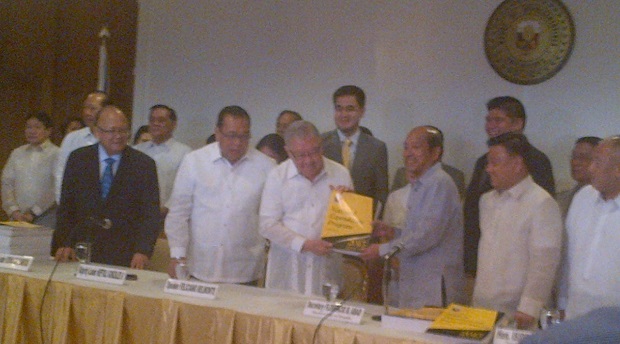The P2.6T proposed budget: Where will it be spent?

Budget secretary Florencio “Butch” Abad on Wednesday submits to the House of Representatives P2.606 trillion proposed national budget for 2015. MARC JAYSON CAYABYAB
MANILA, Philippines — Where exactly will the country’s funds be spent, if the proposed P2.6 trillion national budget for 2015 is to be approved?
INQUIRER.net gives a breakdown based on the primer on the budget submitted to the House of Representatives on Wednesday.
Infrastructure and other capital outlays received the lion’s share of the budget at P506.4 billion.
There are other new government programs that would need funding, as well.
One of which is for the implementation of the Bangsamoro Basic Law, which has yet to be filed in Congress following the recently signed peace accord between government and the Moro Islamic Liberation Front.
Article continues after this advertisementThe law, which calls for a plebiscite for the establishment of a Bangsamoro entity, would be funded with P2.7 billion.
Article continues after this advertisementSuch interventions under the budget would include the disarming of combatants, conversion of bases to productive economic hubs, among others.
Also, the Reproductive Health law, which hurdled a legal impediment after it was declared constitutional by the Supreme Court, would receive P3.3 billion under the proposed law.
This will include giving vitamin supplements to children under five years old, as well as family planning commodities like condoms to women.
Social services get the biggest bite of the pie among the sectors funded by the budget.
This includes the government’s poverty alleviation program Conditional Cash Transfer, which would get P64.7 billion for the inclusion of 4.4 million poor households.
Under the dole-out program of giving cash incentives to poor families who fulfill certain livelihood standards, two million families will be able to uplift themselves from survival to subsistence, and another 300,000 from subsistence to self-sufficiency.
For education, the government seeks a P364.9 billion budget for the hiring of 39,006 more teachers, and the construction of 31,728 more classrooms in 2015.
For health, the government wants a P13.1 billion budget for the upgrade of 1,242 barangay (village) health stations, 587 rural health stations, 128 local government unit hospitals, and 11 treatment and rehabilitation centers.
The government also seeks a P3.3 billion budget to immunize 2.2 million children and to provide pneumococcal vaccines to 1.4 million senior citizens and 429,000 infants.
For housing, the government wants P7.3 billion to relocate 15,862 families from danger zones. Also, P577 million would be for the continuation of the government’s resettlement program.
Even victims of Yolanda, the world’s strongest typhoon to hit land, will have a share of the budget. The government seeks P736 million for emergency housing assistance for 26,426 victims.
For tertiary education, government seeks a P43.3 billion for state universities and colleges, a 13.8 percent increase from 2014.
The administration also wants least P2.2 billion for scholarships under the Commission on Higher Education, and P2 billion for trainings of 210,526 workers under Tesda.
For transportation, the government wants to spend P230.4 billion to lower the cost of and reduce time for transporting goods and people and thus to spur more trade and investment.
The government also seeks a P195.1 billion for road transportation to maintain roads in good condition.
On top of that, a P16.9 billion in subsidy was also included in the budget for railways including the Light Rail Transit 1 and LRT 2, Metro Rail Transit 3, and the Philippine National Railways.
For agriculture, the administration wants to invest P26 billion in agriculture infrastructure for 20,650 hectares. Also, the government wants to allocate P4.09 billion for the Philippine Coconut Authority.
For climate change, the government wants to have P45.1 billion for flood control under the budget of the Department of Public Works and Highways.
For tourism, the administration wants to have P16.2 billion for the construction and upgrades of roads and bridges to airports, seaports and tourist destinations. The government also wants to have P592 million to modernize and increase capacity of existing airports.
The breakdown of the P2.606 trillion budget:
Social services – P967.9 billion up from P841.8 billion in 2014
Economic services – P700.2 billion, up from P593.1 billion
General public services – P423.1 billion up from P362.6 billion
Debt burden – P399.4 billion up from P377.6 billion
Defense – P115.5 billion up from P89.5 billion
Social services topped the sector with 37.1 percent of the pie, followed by economic services with 26.9 percent, general public services with 16.2 percent, debt burden with 15.3 percent, and defense with 4.4 percent.
The Department of Education topped the government agencies receiving the lion share of the budget with P365.958 billion.
It is followed by:
Department of Public Works and Highways – P300.519 billion
National Defense – P144.036 billion
Interior and Local Government – P141.423 billion
Social Welfare and Development – P108.97 billion
Health – P102.178 billion
Agriculture -P88.818 billion
Transportation and Communication – P59.463 billion
Environment and Natural Resources – P21.290 billion
Judiciary – P20.285 billion
RELATED STORIES
‘Pork’-less 2015 national budget amounts to P2.6T
PH infrastructure budget has doubled since 2011